|
| Edgemont, Keene |
|
|
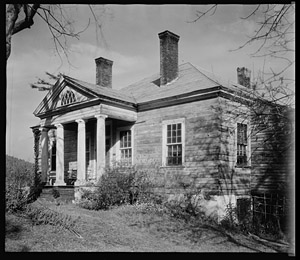 Date: 1935
Date: 1935
Image Number: Library of Congress, LC_DIG_csas_04140
Comments:
Edgemont was built in 1796 for James Powell Cocke, a justice of Henrico County, who moved to Albemarle County for its healthful climate as
he suffered from Malaria. The design of this home is often credited to Thomas Jefferson based upon the Villa Rotunda design of
Palladio. Cocke's nephew, Dr. Charles Cocke, would live nearby at Esmont plantation about two decades after the construction of
Edgemont.
Copyright � 2018 by Scottsville Museum
|
| Enniscorthy, Esmont |
|
|
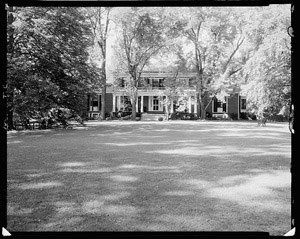 Date: 1932
Date: 1932
Image Number: Library of Congress, LC_DIG_csas_04142
Comments: The Coles family arrived in Albemarle County between 1730 and 1747. John Coles I (1705-1747), the immigrant,
purchased the land on Green Mountain Road as a hunting retreat, later establishing a permanent residence known as Enniscorthy.
Coles named this estate for his hometown of Enniscorthy in County Wexford, Ireland. When Coles passed away in 1747, Enniscorthy
passed to his son, John Coles II. In 1781, during the American Revolution, Thomas Jefferson fled to Enniscorthy to evade capture by
British soldiers. In 1789, a plantation house was built at Enniscorthy, which was destroyed by fire in 1839. The Enniscorthy
home shown in this photo was built circa 1850.
Copyright � 2018 by Scottsville Museum
|
|
| Esmont, Esmont |
|
|
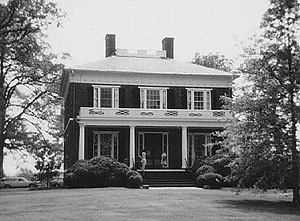 Date: ca. 1960
Date: ca. 1960
Image Number: WPFJ_UVA1Esmont
Comments:
The Esmont house was built ca. 1816 for Doctor Charles Cocke, nephew of James Powell Cocke of nearby Edgemont in Esmont, VA. Esmont was a
major plantation, and over thirty slaves were held on the property in 1849. The Esmont property once spread over 2,000 acres, but in
2018 it consists of 105 acres. The Lane Brothers, who owned the property at the turn of the 20th century, parcelled off a significant
portion of land from the Esmont estate to build an industrial village of the same name.
Copyright � 2018 by Scottsville Museum
|
|
| Estouteville, Esmont |
|
|
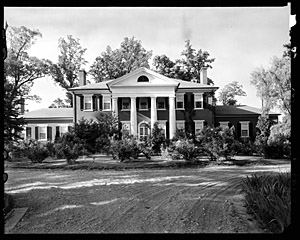 Date: 1932
Date: 1932
Image Number: Library of Congress, Estouteville_LC_DIG_csas_04157
Comments: Estouteville was built ca. 1827 for John Coles, III, and family. A house named "Calycanthus Hill", built in
1800, previously stood on this property. Master joiner James Dinsmore, assisted by brick mason William B. Phillips, built Estouteville
immediately to the south of the old house. After Estouteville was built, the older house was converted to an orangery and burned in 1856.
James Dinsmore had previously served as Thomas Jefferson's master carpenter for ten years, and Estouteville was one of Dinsmore's crowning
achievements. Estouteville is noted for its grand Tuscan exterior porticoes and great interior hall with an elaborate Doric frieze.
Copyright � 2018 by Scottsville Museum
|
|
| Guthrie Hall, Esmont |
|
|
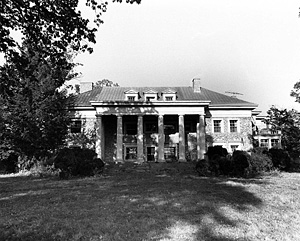 Date: ca. 1981
Date: ca. 1981
Image Number: Virginia Department of Historic Resources, 002-055 Guthrie Hall,
Comments: Guthrie Hall was built ca. 1901 for John Guthrie Hopkins, a Scottish-born, self-made copper magnate who came
to Virginia to pursue his hobby of restoring old houses. The house was designed by Frederick Hill, an architect with the firm of
McKim, Mead, and White. In addition to the fine interiors of the main house, the Guthrie estate included a private railroad station and a
bowling alley.
Copyright � 2018 by Scottsville Museum
|
|
| Mountain Grove, Schuyler |
|
|
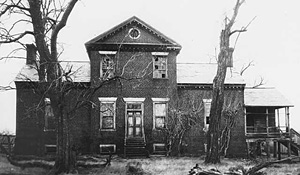 Date: undated
Date: undated
Image Number: UVA Library, Mountain Grove, Accession #83437
Comments: Mountain Grove in Schuyler was built in 1803-1804 for Captain Benjamin Harris, a soldier in the Virginia State Militia during the
Revolution and a magistrate in 1791. Mountain Grove was built in the classic Virginia Palladian style. Its tripartite form is composed of a two-story, three bay center block
flanked by single-bay, 1 1/2-story wings. Strongly Jeffersonian in design, Mountain Grove is not unlike the earliest designs for Monticello.
Copyright � 2018 by Scottsville Museum
|
|
| Nydrie, Esmont |
|
|
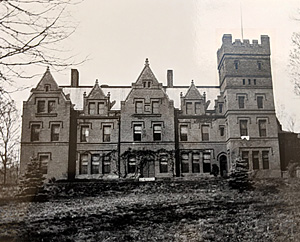 Date: ca. 1920
Date: ca. 1920
Image Number: UVA Library, Nydrie, Accession #10758-a
Comments: In the 1890's, Harry Douglas Forsyth purchased the Tom Coles Farm at Green Mountain in southern Albemarle County,
Virginia, and it contained some seven hundred acres of land. Forsyth was a British-born financier and sugar baron who had moved from
New Orleans to southern Albemarle with his wife, Sarah Rice Johnson Forsyth. By 1898, the Forsyth commissioned the building of Nydrie,
a massive manor house modeled after a Scottish baronial castle Nydrie contained fifty rooms, not including hallways and the basement.
An equally immense set of stables and several good houses for estate workers had been built on the Forsyths' property prior to erecting the
Nydrie house shown above.
Copyright � 2018 by Scottsville Museum
|
|
| Old Woodville, Esmont |
|
|
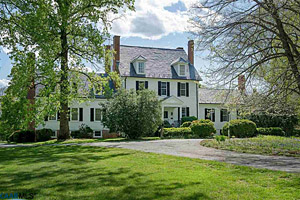 Date: 2018
Date: 2018
Image Number: Old Woodville,
M57953-09909#photo43
Comments: Woodville was built in 1796 by prominent Virginia planter John Coles, II, of nearby Enniscorthy. Coles
built this two-story, double-pile frame house for his son, Walter Coles (1772-1854). An addition was made to the west side of this
house in 1832. According to photographer, Frances Benjamin Johnston (1864-1852), who worked for the Carnegie Survey of the Architecture
of the South, four generations of Coles occupied the house from its completion until the Coles sold the Woodville property to Charles Shaw
in the late 1800s. Shaw renamed the property. The Coles, meanwhile, built a new home, giving it the same name as their former property, Woodville. Later,
the Coles family rebought the first Woodville property, and, to distinguish the two Woodvilles from each other, they referred to the 1796
house as 'Old Woodville.' Old Woodville is located at 6774 Green Mountain Road in Esmont, Virginia.
Copyright � 2018 by Scottsville Museum
|
|
| Plain Dealing, Keene |
|
|
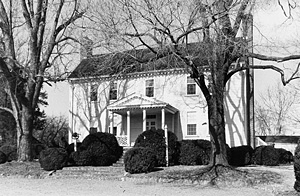 Date: 1977
Date: 1977
Image Number: Virginia Department of Historic Resources, 002-0065 Plain Dealing
Comments: The main residence was built on land patented by Thomas Staples in 1783-84 and is believed to have consisted of a
smaller story-and-a-half section of the house. In 1787, Staples sold 500 acres of this property to Samuel Dyer, who expanded the
original house by building the two-story main section of this H-shaped house soon thereafter. Dyer also operated a very successful store on his farm then
located on the busy road from Scottsville to Staunton. His store bore a sign bearing the motto 'Plain Dealing', and Dyer then named his
house 'Plain Dealing.'
Copyright � 2018 by Scottsville Museum
|
|
| Tallwood, Keene |
|
|
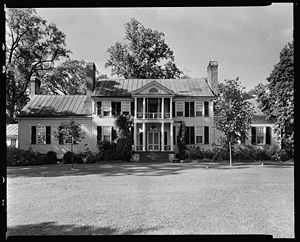 Date: 1932
Date: 1932
Image Number: Library of Congress, LC-DIG-csas-04313
Comments: Tallwood, located on Green Mountain near Keene, was built in 1803 for Tucker Coles (1782-1861) and his wife,
Helen Skipwith Coles. The Tallwood estate is one of three family estates carved from the original tract of land belonging to John
Coles II (1745-1808) of Enniscorthy. The account book of John Coles II mentions that he insured Tallwood against fire in 1805.
Copyright � 2018 by Scottsville Museum
|
|
| Tros-Dale Home for Boys, Keene |
|
|
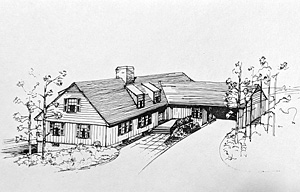 Date: Built ca. 1965
Date: Built ca. 1965
Image Number: UVA Library, Tros-Dale Home for Boys (Keene, VA) ca. 1965
Comments: The Tros-Dale Home for Boys is located near Keene, Virginia, and its building was completed in 1966.
Peter T. Way was the founder and Director of the Tros-Dale Home. Director Way's goal was to provide a small, family-oriented home
for boys rather than one of the large children's institutions that were in existence in Virginia in 1965. He succeeded and had a strong
and lasting influence on the lives of many boys during his Tenure as Director of the Tros-dale Home. The Tros-dale Home for Boys relied
greatly on philanthropy for its funding and remained in existence until the early 1980's.
Copyright � 2018 by Scottsville Museum
|
|
| Coleswood, Esmont |
|
|
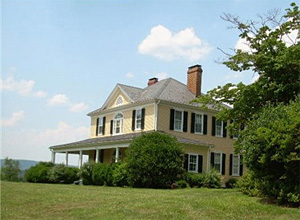 Date: ca. 2000
Date: ca. 2000
Image Number: Coleswood_GISAlbemarle
Comments: When Peyton Skipwith Coles sold Tallwood to William D. Waters in 1897, he reserved about 184 acres on the north
side of Tallwood next to the Enniscorthy estate running from Green Mountain Road almost to Sand Ridge Road. In 1903-1904, Coles erected
a new dwelling house on this acreage with necessary out-buildings and farm buildings, and he called his new home 'Coleswood.' The Coleswood
lawn runs up to the woods which screen the house from the Green Mountain Road, and it is because of these woods that the house takes its name.
The front gate at Coleswood, which is a double gate made of iron with granite gate-posts, was formerly the front gate at Estouteville.
The Coleswood dwelling house was remodeled in 2004. In 2018, the Coleswood property, located at 6198 Green Mountain Road in Esmont, is
the property of the John C. Pierce Farm, Inc., and the company's registered agent is J. Paula Pierce.
Copyright � 2018 by Scottsville Museum
|




